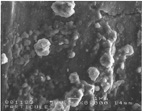Thermomechanics of Interfaces
and Living Tissues
Description
After joint arthroplasty, mechanical and thermal problems at the
interface are very sensitive to minor changes of contacting boundaries of the
bone, cement and implants. This sensitivity is increased by
thermoelastic distortion. It may have important consequence of the
longterm reliability of the implant anchorage, particularly on the
generation of microcraks within the cement mantle.
 Orthopaedic cement debris at the
Orthopaedic cement debris at the
cemented bone-implant interface
(After E Charriere et al., 1998)
Some biological
complications might be related to the heat generated by the exothermic
polymerization of the orthopaedic cement. Bone necrosis at the
bone-cement interface may occur during and after the surgical
implantation.
 Temperature distribution at
the cemented bone- femoral implant
Temperature distribution at
the cemented bone- femoral implant
interface after polymerization (cement thickness : 3 mm, 5 mm)
(After Ramaniraka and Rakotomanana, 2004)
This may induce bone resorption at the bone-cement
interface, leading implant lose. To name but several, stem temperature,
cement temperature, polymerization temperature, thermoelastic
properties of bone, stem surface,
and their evolution, cement and stem including the
shrinkage stresses of
the cement, certainly affect the quality
of the anchorage.
As a starting point, accurate calculation of the bone-implant relative
micromotions and interfacial stresses becomes a keypoint for any
quantitative analysis of the mechanical environnement acting on the
bone tissue end cells. The purpose of this topic research was to
present theoretical models
and computational methods
to analyse the fixation of orthopedic implants.
In addition to thermomechanics aspects, the evolution of living tissue
properties at the interface
also plays important role for estimating the long-term evolution of
orthopaedic implant anchorage. To this end, model of tissue
differentiation at the bone-implant interface is proposed assumingthat
that the mechanical environment determines the tissue differentiation.
The stimulus chosen is related to the bone-implant relative micromotions and interfacial stress transfer.
Selected references
Rakotomanana LR, Ramaniraka NA.
Thermomechanics of bone-implant
interfaces after cemented joint arthroplasty: theoretical models and
computational aspects, in Computational
Bioengineering: Current Trends and Applications, World
scientific, Imperial College Press, pp185 - 214, 2004.
Peter B, Ramaniraka N, Zambelli PY, Rakotomanana L, and Pioletti
DP.
Peri-implant bone remodeling after total hip replacement combined with
systemic alendronate treatment: a finite element method analysis. Computer Methods in Biomechanics and
Biomedical Engineering, 7: pp 73-78, 2004.
Buechler Ph, Pioletti DP, Rakotomanana LR, Biphasic constitutive
laws
for biological interface evolution, Biomechanics
and Modeling in Mechanobiology, 4, 239-249, 2003.
Pioletti DP, Mueller J, Rakotomanana LR, Corbeil J, and Wild E.
Effect
of micro-mechanical stimulations on osteoblasts: development of a
device simulating the mechanical situation at the bone-implant
interface, Journal of Biomechanics,
vol 36/1, pp 131-135, 2002.
Ramaniraka NA, Rakotomanana LR, Leyvraz PF. The fixation of
cemented
femoral component: Effects of the stem stiffness, cement thickness and
cement-bone rugosity, Journal of
Bone and Joint Surgery-B, vol. 82-B, 2, pp 297-303, 2000.
Rubin PJ, Rakotomanana RL, Leyvraz PF, Zysset PK, Curnier A,
Heegaard
JH. Frictional interface micromotions and anisotropic stress
distribution in a femoral total hip component, Journal of Biomechanics, 26, 6, pp
725-739, 1993.
Rakotomanana RL, Leyvraz PF, Curnier A, Heegaard JH, Rubin PJ. A
finite
element model for evaluation of tibial prosthesis-bone interface in
total knee replacement, Journal of
Biomechanics, 25, 12, pp 1413-1424, 1992.


